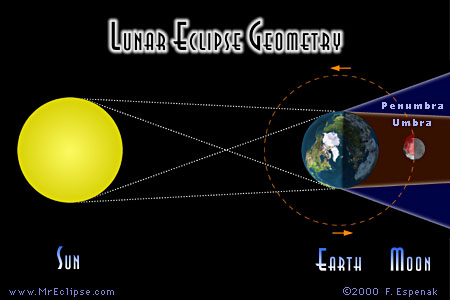Earth Revolution地球公轉
When the Earth revolves around the sun that takes about 365 days.

Lunar Revolution月亮公轉
When the moon revolves around the earth that takes about 29.5 days.

Partial Eclipse偏食
It is when part of the moon/earth is covering by the penumbra.

Total Eclipse全食
It is when the moon/earth is totally cover by the umbra.

Lunar Eclipse月食
It happens during full moon phase when the moon moves behind the earth and cover by the earth's shadow

Solar Eclipse日食
It happens during new moon phase when the moon is in between the sun and the earth and blocks the light from the sun.

Penumbra半影
The lighter part of the shadow

Umbra暗影/本影
The darker part of the shadow

SUMMARY
There are two main types of eclipses, solar and lunar eclipse. Before we get to the main topic, we need to know some basic ideas about how the eclipse occurs. Earth revolution is when the earth revolves around sun and lunar revolution is when the moon revolves around the moon. The movement of the earth and the moon causes different types of eclipse. Total eclipse is when the the moon or the earth is totally cover by the umbra, which is the darker part of the shadow. Partial eclipse is when part of the moon or the earth is cover by the penumbra, which is the lighter part of the shadow. Solar eclipse is when the moon moves between the earth and the sun and blocks the light from the sun, it happens during the new moon phase. Lunar eclipse happens during full moon phase when the moon moves behing the earth and into the earth shadow.
VIDEO
Class J - #3 - 2012 from Kara MacDevitt on Vimeo.
CRITICAL THINKING QUESTION
How is earth affected by movement(revolution)?
The earth is affected by its movement. The earth revolution takes about 365days, and rotation on its axis is about 24 hours. Earth tilted 23.5 degrees to the north star. The rotation casues day and night on the earth and the revolution of the earth around the sun also causes 4 different seasons on the earth which are Spring, Summer, Fall and Winter. And because the earth is tilted and the orbit is ellipse, the earth gets different types of sunlight from the sun--indirect and direct sunlight. Which causes Spring and fall equinoxes, Summer and winter solstices. The moon phases(New moon, waning cresent/gibbous moon, first/last quarter moon, full moon, waxing cresent/gibbous moon), eclipses(total/partial solar/lunar eclipse), and spring/neap tides also occur because of the movement of earth.
REFLECTION
What did you enjoy most about this project and why?
I enjoyed the editing part the most, because I can make our group's great video even better and able to delete some parts of the video that are not good. An because I like to work on iMovie. Well, since I was the one who made the pictures and other props, I feel satisfied after I finished making them all and saw them used in the vidoe!
What was most challenging for you during this project and why?
I think the most challenging part would be the part in video that I have to move the moon above the paper to create a view that the small tiny moon is covering the huge sun. >.<
What new skills did you learn from doing this project?
I have used iMovie before, but I found out the software is more efficient and better in many ways than before. This advantage helps me to do things that I want to do to our video that I couldn't do before. ;)
Is there anything that you could have done to improve any of your work? Explain.
I think I should double check the editing of the video. Because the last part when I put up every one's job and their names, I put "narrator", but because of the font or the size of the word, it didn't show the whole word but only "narrat", which looks bad. :(